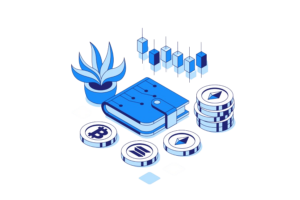Ethereum is a decentralized, open-source blockchain platform that enables developers to build and deploy smart contracts and decentralized applications. It features its native cryptocurrency, Ether (ETH), which is used for transaction fees and computational services within the network. Ethereum’s primary focus is on programmability and versatility, allowing for a wide range of use cases, including decentralized finance (DeFi), non-fungible tokens (NFTs), and more.
Key Takeaways
- Ethereum has a broad range of use cases, including decentralized finance (DeFi), non-fungible tokens (NFTs), and digital identity solutions.
- Ethereum 2.0, a major upgrade to the network, aims to address scalability, security, and sustainability concerns.
- The platform faces competition from other blockchain platforms, but its versatility and continuous development help maintain its position as a leading smart contract platform.
- Ethereum has the potential to disrupt and transform various industries, promoting transparency, efficiency, and innovation.
- Developers can leverage programming languages like Solidity, as well as frameworks and tools, to build and deploy decentralized applications on Ethereum.
- Gas, measured in Ether, is used to quantify computational effort and allocate network resources efficiently.
- NFTs and DeFi applications built on Ethereum have gained significant popularity, driving further adoption of the platform.
- Ethereum’s future outlook is marked by both challenges and opportunities, with the potential to play a pivotal role in shaping the future of decentralized technology.
Introduction
Origin and History
Ethereum was conceived in 2013 by a young programmer named Vitalik Buterin, who sought to create a more versatile and adaptable blockchain platform compared to Bitcoin. In 2014, the Ethereum project raised funds through a successful Initial Coin Offering (ICO), and the platform officially went live in 2015. In the years that have followed, Ethereum has grown to become the second-largest cryptocurrency by market cap and has attracted a vibrant community of developers, enthusiasts, and HODLers.
Purpose and Vision
The primary vision behind Ethereum is to create a decentralized, global platform that enables developers to build and deploy a wide array of applications using blockchain technology. By harnessing the power of smart contracts, Ethereum aims to remove the need for intermediaries and central authorities in various industries. This vision promotes a more transparent, secure, and efficient way of conducting business, exchanging value, and executing agreements.
Ethereum as a Platform
Ethereum is more than just a cryptocurrency; it is a comprehensive platform that provides the necessary tools and infrastructure for creating decentralized applications (dApps). These dApps can range from simple token exchanges to complex financial services, gaming platforms, and supply chain management systems. Ethereum’s versatility has made it the go-to platform for numerous groundbreaking innovations, such as decentralized finance (DeFi) and non-fungible tokens (NFTs). In essence, Ethereum has opened the door to a new world of possibilities in the realm of blockchain technology, reshaping the way we interact with digital assets and services.

Ethereum’s Blockchain Technology
At its core, Ethereum’s blockchain functions as a distributed, decentralized ledger that records transactions and smart contract executions. Each node in the Ethereum network maintains a copy of the blockchain, and transactions are grouped into blocks that are cryptographically linked to the previous block, forming a chain.
How Ethereum’s Blockchain Works
The Ethereum blockchain relies on consensus algorithms to validate transactions and secure the network. Miners or validators process and confirm transactions, and the blockchain rewards them with newly minted Ether (ETH) for their efforts. This process ensures that the network remains secure and maintains its integrity.
Proof of Work vs. Proof of Stake
Ethereum initially used a consensus algorithm called Proof of Work (PoW), which is also employed by Bitcoin. In PoW, miners solve complex mathematical puzzles to create new blocks and validate transactions. However, PoW has some drawbacks, such as high energy consumption and the potential for mining centralization.
To address these issues, Ethereum transitioned to a Proof of Stake (PoS) consensus algorithm, known as Ethereum 2.0. In PoS, validators are chosen to create new blocks and validate transactions based on the amount of cryptocurrency they hold (their stake) and other factors. PoS is more energy-efficient and reduces the risks associated with mining centralization.
Ethereum 2.0 and Its Implications
Ethereum 2.0 was a significant upgrade to the Ethereum network that aims to improve its scalability, security, and sustainability. This upgrade was implemented in multiple phases, with the first phase (the Beacon Chain) having launched in December 2020. The final phase, The Merge,
Ethereum 2.0 brings several key changes to the platform, including:
- Transition to Proof of Stake: As mentioned earlier, Ethereum has moved away from PoW to PoS, which will lower energy consumption and reduce centralization risks.
- Sharding: Ethereum 2.0 introduces a technique called sharding, which splits the network into smaller, interconnected chains called shards. This process increases transaction throughput and improves the overall performance of the network.
- eWASM: Ethereum 2.0 will replace the Ethereum Virtual Machine (EVM) with a new execution engine called eWASM (Ethereum-flavored WebAssembly). This change aims to enhance the platform’s flexibility and support a broader range of programming languages.
The transition to Ethereum 2.0 will continue to have far-reaching implications for developers, users, and the entire blockchain ecosystem. It will enable Ethereum to handle more transactions, support more complex dApps, and further solidify its position as a leading blockchain platform.
Smart Contracts: A Core Feature of Ethereum
What Are Smart Contracts?
Smart contracts are self-executing agreements with terms and conditions directly written into code. They run on the Ethereum blockchain, providing transparency, security, and efficiency. When specific predetermined conditions are met, smart contracts automatically execute the agreed-upon actions without the need for intermediaries or manual intervention.
Use Cases and Benefits
Smart contracts have a wide range of applications across various industries, with some notable use cases including:
- Finance: Decentralized finance (DeFi) relies heavily on smart contracts to enable lending, borrowing, and trading services without traditional financial institutions.
- Supply Chain Management: Smart contracts can be used to streamline and automate processes in supply chains, enhancing transparency and traceability.
- Insurance: Smart contracts can help automate the processing of insurance claims, reducing bureaucracy and ensuring timely payouts.
- Voting: Secure and transparent voting systems can be built using smart contracts to minimize fraud and provide real-time, verifiable results.
- Real Estate: Smart contracts can facilitate property transactions, automating processes like escrow, title transfers, and payments.
The benefits of smart contracts include:
- Trustless: Since they are stored on a decentralized blockchain, smart contracts eliminate the need for trust in a central authority.
- Efficiency: By automating processes and removing intermediaries, smart contracts can save time and reduce costs.
- Transparency: All transactions and terms of the contract are visible on the public blockchain, promoting accountability and trust.
- Security: Blockchain’s cryptographic nature ensures that smart contracts are secure and tamper-proof.
Creating and Deploying Smart Contracts
To create a smart contract on the Ethereum platform, developers typically use a programming language called Solidity. Solidity is designed specifically for writing smart contracts and is similar to JavaScript in syntax.
The process of creating and deploying a smart contract involves several steps:
- Write the smart contract code: Using Solidity, developers can define the contract’s functions, variables, and conditions. They should also include any necessary error handling and security measures.
- Compile the code: After writing the smart contract code, it must be compiled to bytecode, which can be executed on the Ethereum Virtual Machine (EVM).
- Deploy the smart contract: Developers need to deploy the compiled smart contract to the Ethereum network. This process involves sending a transaction with the contract’s bytecode and any required constructor arguments. A small amount of Ether (ETH) is also needed to cover the deployment’s gas fees.
- Interact with the smart contract: Once deployed, users can interact with the smart contract by sending transactions that call its functions. These transactions also require Ether (ETH) to cover gas fees.
Smart contracts are a fundamental aspect of Ethereum, enabling a wide range of applications and transforming how we conduct business, exchange value, and manage processes across various industries.
Ethereum’s Native Cryptocurrency: Ether (ETH)
Ether as a Digital Currency
Ether (ETH) is the native cryptocurrency of the Ethereum network, serving various purposes within the ecosystem. As a digital currency, Ether can be traded, bought, and sold on cryptocurrency exchanges, much like Bitcoin. Users can store Ether in digital wallets and transfer it to others as a form of payment or investment. Additionally, Ether is essential for powering various applications and transactions on the Ethereum platform.
Gas and Transaction Fees
In the Ethereum network, “gas” represents the computational effort required to execute transactions and smart contracts. Each operation on the platform consumes a certain amount of gas, which must be paid in Ether. The more complex a transaction or smart contract, the more gas it requires.
Transaction fees in Ethereum are calculated based on two factors: gas used and gas price. The gas price is measured in Gwei (1 Gwei = 0.000000001 ETH) and reflects how much a user is willing to pay for each unit of gas. Miners or validators prioritize transactions with higher gas prices, so setting a higher gas price can lead to faster confirmation times.
These transaction fees serve a dual purpose: they incentivize miners or validators to secure the network and process transactions, and they prevent spam or abuse by attaching a cost to every operation on the platform.
ETH Mining and Staking
Initially, Ethereum relied on mining, a process where miners competed to solve complex mathematical puzzles using Proof of Work (PoW) to add new blocks to the blockchain. Miners were rewarded with newly minted Ether for their efforts. However, as previously mentioned, Ethereum is transitioning to a Proof of Stake (PoS) consensus algorithm through Ethereum 2.0, significantly changing how the network is secured and Ether is generated.
Under PoS, users can become validators by “staking” a specified amount of Ether in a smart contract. Validators are then chosen to propose and validate new blocks based on their stake, among other factors. Validators who successfully propose and validate blocks receive rewards in the form of Ether.
Staking has several advantages over mining, such as lower energy consumption, reduced centralization risks, and a more accessible method of securing the network for users with smaller amounts of Ether.
Ether plays a crucial role in the Ethereum ecosystem, serving as both a digital currency and the fuel for transactions and smart contracts. With the transition to Ethereum 2.0, the way Ether is generated and used within the network will continue to evolve, further expanding the platform’s potential.
Decentralized Finance (DeFi) on Ethereum
Introduction to DeFi
Decentralized Finance (DeFi) refers to a movement that leverages blockchain technology to create open, permissionless, and transparent financial services without relying on traditional intermediaries like banks, brokers, or insurance companies. DeFi leverages smart contracts, particularly on the Ethereum network, to offer various financial products and services such as lending, borrowing, trading, and asset management.
Popular DeFi Projects on Ethereum
Ethereum is the leading platform for DeFi, hosting numerous projects that contribute to the expanding DeFi ecosystem. Some popular DeFi projects on Ethereum include:
- MakerDAO: A decentralized credit platform that allows users to borrow the stablecoin DAI against their crypto assets. DAI maintains its value pegged to the US Dollar, providing stability in a volatile market.
- Aave: A decentralized lending and borrowing protocol that enables users to earn interest on their deposits or borrow against their digital assets.
- Uniswap: A decentralized exchange (DEX) that allows users to trade Ethereum-based tokens without a centralized intermediary. Uniswap employs an innovative automated market-making (AMM) system, using liquidity pools instead of traditional order books.
- Compound: A decentralized lending platform where users can supply and borrow cryptocurrencies, earning interest on their deposits or paying interest on their loans.
- Yearn. Finance: An automated yield farming platform that optimizes users’ investments by allocating their funds to the most profitable DeFi lending and liquidity provision opportunities.
Impact on the Financial Ecosystem
DeFi on Ethereum has the potential to significantly disrupt and reshape the traditional financial ecosystem. Some notable impacts include:
- Accessibility: DeFi democratizes access to financial services, enabling users worldwide to participate in the financial ecosystem without the need for a bank account or credit history.
- Cost Reduction: By removing intermediaries, DeFi can lower the fees associated with various financial transactions, making them more affordable for users.
- Transparency: DeFi applications are built on public blockchains like Ethereum, providing an unprecedented level of transparency into the inner workings of financial services.
- Innovation: DeFi has spurred the creation of novel financial products and services, pushing the boundaries of what is possible in the financial industry.
- Efficiency: DeFi applications can automate many traditional financial processes, leading to increased efficiency and reduced processing times for various transactions.
Decentralized Finance (DeFi) on Ethereum is revolutionizing the financial industry by offering open, transparent, and accessible alternatives to traditional financial services. As the DeFi ecosystem continues to grow and mature, its impact on the financial sector is expected to increase, paving the way for a more inclusive and innovative financial future.
Non-Fungible Tokens (NFTs) and Ethereum
What Are NFTs?
Non-Fungible Tokens (NFTs) are unique digital assets that represent ownership or proof of authenticity for a wide range of items, such as art, collectibles, virtual goods, and more. Unlike cryptocurrencies like Bitcoin or Ether, NFTs are not interchangeable, as each token has distinct properties and values. This non-fungibility makes them suitable for representing one-of-a-kind assets in the digital world.
The Role of Ethereum in the NFT Ecosystem
Ethereum plays a crucial role in the NFT ecosystem, as it provides the underlying infrastructure for creating, managing, and trading NFTs. Most NFTs are built on Ethereum’s ERC-721 or ERC-1155 token standards, which define a set of rules and functions for creating and interacting with NFTs on the platform. Ethereum’s smart contracts enable the creation of NFT marketplaces and platforms that allow users to mint, buy, sell, and trade unique digital assets seamlessly and securely.
Notable NFT Projects and Marketplaces
Ethereum hosts a wide array of NFT projects and marketplaces, catering to different sectors and interests. Some notable examples include:
- CryptoPunks: One of the earliest and most iconic NFT projects, CryptoPunks features a collection of 10,000 unique, pixelated characters that have become highly sought-after digital collectibles.
- CryptoKitties: A popular NFT-based game where users can collect, breed, and trade unique virtual cats. CryptoKitties gained widespread attention in 2017, showcasing the potential of NFTs in gaming and digital collectibles.
- Decentraland: A virtual world built on Ethereum where users can purchase, develop, and trade land parcels (represented as NFTs) to create immersive experiences and interact with other users.
- OpenSea: A leading NFT marketplace on Ethereum, OpenSea allows users to discover, buy, sell, and trade a wide range of NFTs, including art, collectibles, domain names, and virtual items.
- Rarible: A decentralized NFT marketplace and platform that enables users to mint, buy, and sell unique digital assets. Rarible also features a native governance token (RARI), which incentivizes user participation in the platform’s development.
Non-Fungible Tokens (NFTs) have rapidly gained traction as a new form of digital ownership and expression, with Ethereum at the forefront of this emerging trend. By providing the necessary infrastructure and tools, Ethereum has enabled the growth and evolution of the NFT ecosystem, unlocking new possibilities for creators, collectors, and users alike.
Ethereum Development and Tools
Programming Languages and Frameworks
Developing on the Ethereum platform requires familiarity with various programming languages and frameworks. The most widely used language for writing smart contracts is Solidity, which resembles JavaScript in syntax and design. Other languages like Vyper, a Python-like language, and LLL (Lisp-like Language) are also used, but to a lesser extent.
In addition to programming languages, several frameworks help streamline Ethereum development, including:
- Truffle: A popular development framework that provides an environment for building, testing, and deploying smart contracts.
- Hardhat: A development environment for Ethereum that offers advanced debugging and testing capabilities, as well as extensibility through plugins.
- Embark: A comprehensive framework that simplifies dApp development by integrating smart contracts, decentralized storage, and communication layers.
Developer Tools and Resources
A wide range of developer tools and resources are available to help build and deploy Ethereum-based applications:
- Remix: An open-source web-based IDE for writing, testing, and deploying smart contracts written in Solidity.
- MetaMask: A browser extension and mobile app that serves as an Ethereum wallet and enables users to interact with dApps and manage their digital assets.
- Etherscan: A widely used Ethereum block explorer that allows developers to access information about transactions, addresses, and contracts on the Ethereum network.
- Ganache: A personal blockchain for Ethereum development that allows developers to deploy contracts, develop applications, and run tests in a sandboxed environment.
- Infura: A scalable and reliable API service that provides developers with access to the Ethereum network without the need to run a full node.
Building Decentralized Applications (dApps)
Decentralized applications (dApps) are applications that run on a blockchain, like Ethereum, providing a trustless, transparent, and decentralized experience for users. Building a dApp on Ethereum typically involves the following steps:
- Design and develop smart contracts: Using a programming language like Solidity, create the underlying smart contracts that define the dApp’s functionality and logic.
- Test and deploy smart contracts: Test the smart contracts thoroughly in a local development environment before deploying them to the Ethereum network.
- Develop the frontend: Create a user interface for the dApp using popular web development frameworks and libraries like React or Angular.
- Integrate with Ethereum wallets: Implement wallet functionality, allowing users to interact with the dApp using tools like MetaMask or WalletConnect.
- Monitor and optimize: Monitor the dApp’s performance and optimize it for gas usage, user experience, and security.
Ethereum offers a robust ecosystem of programming languages, frameworks, tools, and resources for developers looking to build and deploy decentralized applications. By leveraging these tools, developers can create innovative and transformative applications that harness the power of blockchain technology.
Future Outlook and Challenges for Ethereum
Scalability and Security Concerns
One of the primary challenges facing Ethereum is scalability. As the network has grown in popularity, increased demand has led to congestion and higher transaction fees. Ethereum 2.0, which introduces a shift from Proof of Work to Proof of Stake, aims to address these scalability issues by implementing sharding and other optimizations.
Security is another concern, as vulnerabilities in smart contracts and other elements of the Ethereum ecosystem can lead to hacks and loss of funds. Ongoing research and development efforts focus on improving Ethereum’s security and robustness, including the use of formal verification tools and best practices in smart contract development.
Competing Platforms
Ethereum faces competition from other blockchain platforms, such as Binance Smart Chain, Cardano, Polkadot, and Solana, which offer alternative solutions for building decentralized applications and financial services. These platforms often claim advantages like higher transaction throughput, lower fees, and improved developer experiences. Ethereum’s ongoing development, including the transition to Ethereum 2.0, aims to address these competitive pressures and maintain its position as the leading smart contract platform.
Ethereum’s Potential Impact on Various Industries
Despite the challenges, Ethereum’s future outlook remains promising. The platform has the potential to disrupt and transform various industries, including finance, supply chain management, gaming, and digital identity. By enabling decentralized applications and trustless interactions, Ethereum can promote transparency, efficiency, and innovation across these sectors.
In the financial sector, DeFi applications built on Ethereum can challenge traditional banking and finance models. Supply chain management can benefit from transparent and tamper-proof records, improving traceability and accountability. The gaming industry can leverage NFTs and decentralized platforms to offer new forms of digital ownership and player-driven economies. Digital identity solutions built on Ethereum can provide secure and privacy-preserving ways to manage personal information online.
Ethereum’s future outlook is marked by both challenges and opportunities. By addressing scalability and security concerns, while continuing to innovate and expand its reach across various industries, Ethereum has the potential to play a pivotal role in shaping the future of decentralized technology.
Final Thoughts
Ethereum has emerged as a game-changing platform in the world of blockchain technology. By enabling developers to create and deploy smart contracts and decentralized applications, it has opened the door to a wide array of innovative use cases and applications, such as DeFi, NFTs, and more.
The continuous development of the Ethereum ecosystem, including the transition to Ethereum 2.0, demonstrates the platform’s commitment to addressing scalability, security, and sustainability concerns. As Ethereum evolves, it is expected to maintain its position as a leading blockchain platform, driving innovation and transforming various industries.
While challenges like network congestion and competition from other platforms remain, Ethereum’s potential to revolutionize the way we interact with digital services, manage assets, and create value is undeniable. As we continue to explore the possibilities enabled by Ethereum, it is clear that this decentralized platform will play a significant role in shaping the future of the digital economy.
We hope you enjoyed this Coinmama Academy article! If you have any questions, drop us a line at support@coinmama.com – we love hearing from our readers and we respond to every single email! And don’t forget to follow us on Facebook, Instagram, and Twitter.
If you’re ready to start building your own cryptocurrency portfolio, just head to our main website or pick up our free self-custody crypto wallet that lets you store your crypto safely and buy Bitcoin directly through the app!
FAQ
What is the difference between Ethereum and Bitcoin?
Bitcoin is the first and most well-known cryptocurrency, designed primarily as a digital currency for peer-to-peer transactions. Ethereum, on the other hand, is a decentralized platform that enables developers to build and deploy smart contracts and decentralized applications. While both use blockchain technology, Ethereum’s primary focus is enabling programmable functionality, making it more versatile than Bitcoin.
How do I get started with Ethereum development?
To start with Ethereum development, you’ll need to learn Solidity, the most popular programming language for writing smart contracts. Familiarize yourself with Ethereum development tools and frameworks like Truffle, Hardhat, and Remix. There are numerous online resources, tutorials, and courses available to help you learn the necessary skills and get started with building your first decentralized application.
What is the role of Gas in the Ethereum network?
Gas is a unit of measurement used to quantify the computational effort required to execute operations on the Ethereum network. Gas is paid in Ether (ETH) and serves as a fee for miners who validate transactions and execute smart contracts. By using Gas, Ethereum ensures that network resources are allocated efficiently and discourages spam and denial-of-service attacks.
How does Ethereum 2.0 improve the platform?
Ethereum 2.0 is a significant upgrade to the Ethereum network, designed to address scalability, security, and sustainability issues. The most notable change is the transition from a Proof of Work consensus mechanism to Proof of Stake, which reduces energy consumption and allows for more efficient transaction processing. Other improvements include sharding, which increases the network’s capacity, and the introduction of new cryptographic techniques for enhanced security.
How can I create and sell NFTs on Ethereum?
To create and sell NFTs on Ethereum, you’ll need to mint a unique token using the ERC-721 or ERC-1155 token standard. Once your NFT is created, you can list it on popular NFT marketplaces like OpenSea or Rarible, where potential buyers can discover and purchase your digital asset.
What are the most popular DeFi projects built on Ethereum?
Some popular DeFi projects built on Ethereum include MakerDAO, Aave, Uniswap, Compound, and Yearn.Finance. These projects offer various financial services such as lending, borrowing, trading, and asset management, all built on Ethereum’s decentralized platform.
How do smart contracts work on the Ethereum platform?
Smart contracts are self-executing agreements with the terms directly written into code. They run on the Ethereum blockchain, making them transparent, tamper-proof, and trustless. Smart contracts automatically execute predefined actions when specific conditions are met, removing the need for intermediaries and reducing the potential for disputes or fraud.





